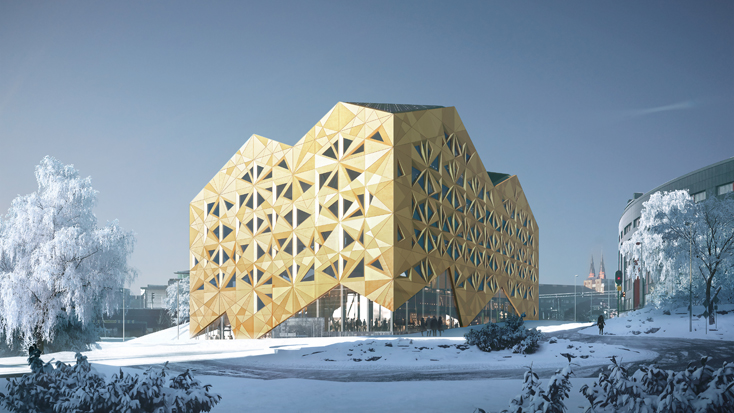Smart Design, Control, and Optimization of Thermal Energy Storage

Amirmohammad Behzadi at the Department of Civil and Architectural Engineering, will publicly defend his doctoral thesis on 28 August 2025.

Why did you choose the topic of your doctoral thesis?
The motivation for this research arises from a gap in the existing literature: despite the considerable focus on Thermal Energy Storage (TES), there is an important need for the smart integration of TES within systems that simultaneously are equipped with High-Temperature Cooling (HTC) and Low-Temperature Heating (LTH) sources. Many studies concentrate solely on LTH applications, while traditional systems frequently depend on simple control strategies that underperform in complex, real-world operations. This observation indicated a need for research on advanced control and optimization frameworks that can unlock the full potential of TES in LTH and HTC systems.
The opportunity to engage with an existing commercial building – Juvelen in Uppsala, managed by Vasakronan and developed by Skanska utilizing its Deep Green concept – provided a significant real-world context for the research. Juvelen ranks among the most energy-efficient buildings in Sweden, utilizing borehole thermal energy storage and district heating without mechanical chillers or heat pumps. However, the system still had room for improvement in cost-effectiveness, dynamic responsiveness, and environmental performance.
This project aimed to investigate the potential of smart control, adaptive operation, and machine learning-based optimization to enhance ultra-efficient buildings' efficiency, environmental friendliness, and cost-effectiveness, thereby contributing to the scientific and practical objectives of the Termo Program by the Swedish Energy Agency and IEA-EBC Annex 37.
What are the most important results?
The proposed system's performance was markedly improved through a series of intelligent upgrades via optimization and control development phases. The integration of artificial neural networks with multi-objective algorithms such as NSGA-II resulted in an 11% enhancement in delivered useful energy, a 14% reduction in costs, and a decrease of 12.2 tons in annual CO₂ emissions. A PSO-optimized adaptive control algorithm that dynamically adjusted radiator supply temperatures according to solar radiation, occupancy, and ventilation achieved a 72.7% reduction in temperature deviation, a 54.4% enhancement in comfort consistency, and a 13.2% decrease in heating energy use. The incorporation of ground-source heat pumps with adaptive seasonal smart control significantly enhanced system performance, achieving a 27% increase in ground heat extraction, a 29% reduction in heating costs, and a decrease in annual CO₂ emissions from 23.9 tons to 1.6 tons despite moderate increases in investment and electricity use. Implementing Model Predictive Control in the enhanced system, which includes integrated heat pumps and hot water storage, showed significant potential, resulting in a reduction of up to 15% in annual operational costs via forecast-based, real-time optimization.
Did you come across something unexpected during your thesis research?
Several important surprises emerged during the research. One was realizing how basic control strategies significantly limited the performance of even advanced buildings like Juvelen. Despite its ultra-efficient design, the lack of smart control hindered energy and comfort performance.
Another positive surprise was the effectiveness of combining machine learning with optimization algorithms—the ANN–NSGA-II framework delivered better results and faster processing than expected.
During the heat pump integration phase, we were inspired by how Skanska's Deep Green Technology was already operating close to optimal, yet we discovered that further improvements were still achievable through smart integration and control.
However, not all findings were promising. One challenge was that, while theoretically powerful, Model Predictive Control proved sensitivity to forecast accuracy and required extensive computational time and data calibration, making real-world implementation more complex than initially expected.
Who will benefit from your results? What kind the impact may it have on surrounding society?
This research offers practical methods for building designers, stakeholders, utility companies, and policy-makers to effectively design and operate smart TES-integrated LTH and HTC systems with advanced controls. It facilitates cost-effective, energy-efficient, and low-emission operations in buildings, including those with existing high-performance systems.
This study directly supports Sweden's climate objectives of achieving net-zero emissions by 2045 and a 50% reduction in energy intensity by 2030, demonstrating how smart integration and machine-learning optimization can significantly decrease energy use, operational costs, and CO₂ emissions.
It also represents Sweden's contribution to IEA-EBC Annex 37, sharing validated models promising smart solutions and strategies internationally, reinforcing Sweden's leadership in sustainable building innovation.
What will you do next and where can one reach you?
After completing my Ph.D., I plan to pursue a postdoctoral research position, concentrating on implementing intelligent and AI-driven renovation decisions in the context of Sweden's aging buildings. While my doctoral work centered on an ultra-efficient new building, my next goal is to adapt and apply this advanced knowledge in older, less efficient buildings, which pose greater practical and policy challenges.
This is particularly significant in Sweden, where approximately 30% of buildings were erected during the 1970s and 1980s and continue functioning under obsolete energy standards (E or lower). These buildings represent significant opportunities for energy-efficient renovation in the next decade and are central to Sweden's national renovation strategy.
Contact me at abehzadi@kth.se or through Linkedin. I am seeking collaborations with researchers, municipalities, and stakeholders focused on sustainable renovation, national carbon neutrality goals, and the green energy transition.
